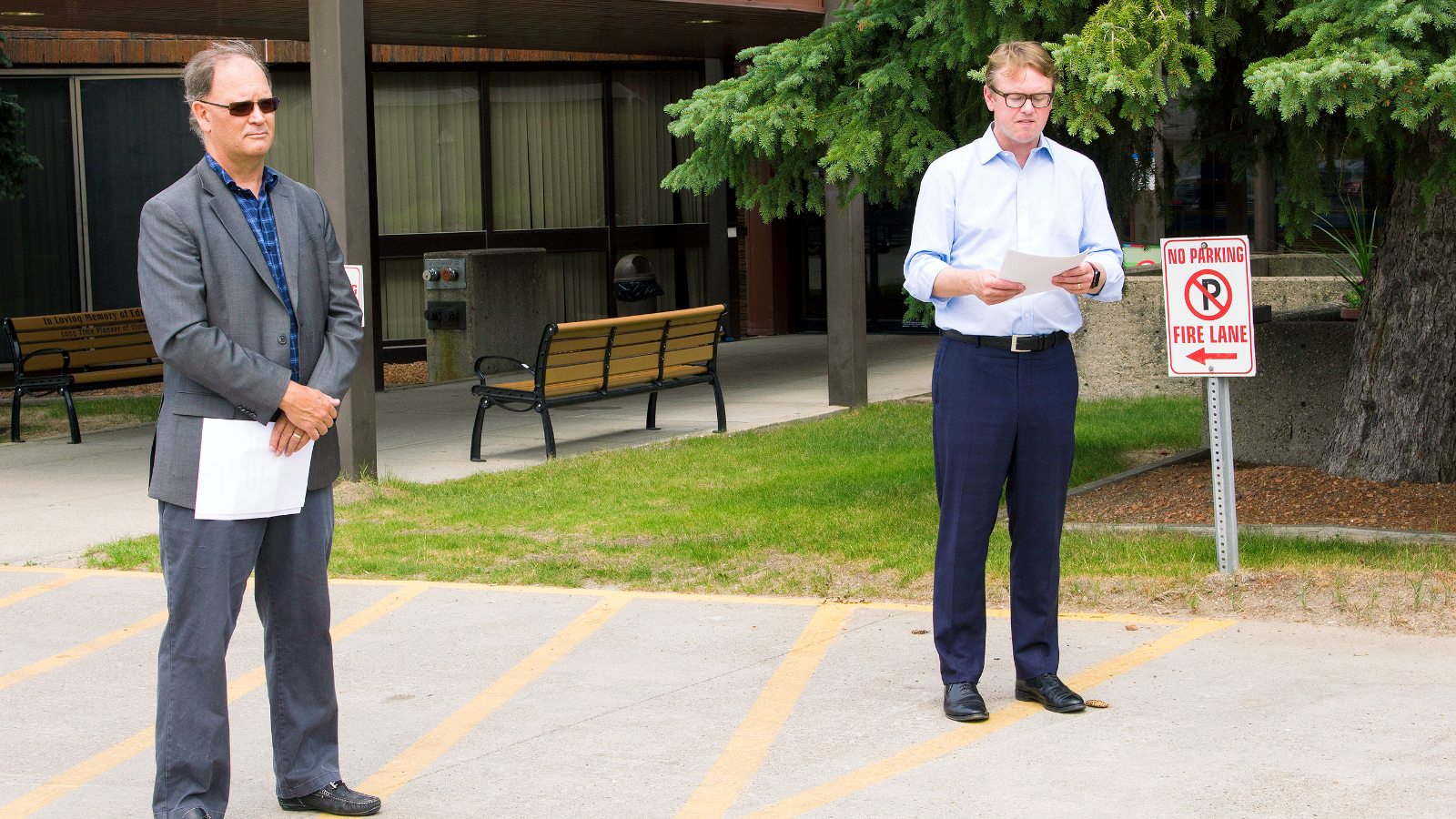Drayton Valley hospital will be receiving a revamp in the coming months.
On July 21 Alberta Minister of Health, Tyler Shandro was at the hospital for a special announcement. The Alberta government is committing $650,000 to renovate the emergency department triage desk. The funding for this project is coming from the Alberta government’s Rural Health Facilities Revitalization Program. This is part of a $50 million commitment from the Alberta government to help revitalize rural hospitals over the next three years.

All Saints Anglican Church
Drayton Valley, All Saints Anglican Church participates in the Anglican Liturgy, which comforts and sustains us. Many have said that in such a busy and changing world it is important to come to a place that feels like home.

Drayton Valley Community Church
DV Community Church. Located at Affinity Funeral Services, officiated by Dwayne Henley.

Church of God
Drayton Valley Church of God. Our Worship Services usually include: traditional hymns, praise choruses, and contemporary songs, prayer, scripture, and a sermon.

Emmaus Lutheran Church
A community of faith passionately walking the road of life with the Lord Jesus. Phone: 780-542-5101, Drayton Valley Alberta
Dr. Chris Birchall Dentistry
Dr. Birchall Dentistry in Drayton Valley, Alberta. A dentist in Drayton Valley, Alberta.
Minister Shandro, alongside MLA Mark Smith and some AHS staff stood in front of the hospital to make the announcement. Smith spoke after Shandro and was enthusiastic about the plan saying, “I want to thank the staff at the Drayton Valley hospital and care centre for the work that they do everyday and as someone who’s lived in this community for the last 35 years I can attest to the care and the quality of care in this hospital.”
In January 1965, the St. Anthony School opened its doors. Now, 60 years later, the school is planning a celebration of the milestone.
Principal Janelle Molzan says they are planning to have a celebration on May 24 at the school gym. They will be using the event to also fundraise for the school.
Molzan says they will have a band performing that evening, catering from a local restaurant, a full cash bar, as well as some door prizes.
Part of the celebration will also be the fact that St. Thomas Aquinas Roman Catholic School Division has put St. Anthony at the top of their priority list for a new school. Molzan says the division has to wait until next year to submit their request to the Province, and there is no guarantee that they will be selected for funding.
“It could be anywhere from two to ten years,” she says. “Or more.”
However, she feels that St. Anthony has a strong case for asking for a new school.
The most recent remodel of the school was in 1992, says Molzan. At that point they expanded the school, removing the gym from the centre of the school and installing classrooms instead. The new gym was then built as an addition to the school.
“We had the addition of the gym as well as a few classrooms in 1992,” says Molzan.
Since then, there have been no major remodels or renovations. Instead, the staff have been doing what they can to keep the building in shape.
“It’s a really well built school,” says Molzan.
She says over the years, the natural heaves and settling that occur with temperature fluctuations has led to some cosmetic damages to the building. “It’s just showing its age,” she says.
While the school is starting to show wear, Molzan says there are no capacity issues. About 15 years ago, the school went from being a K-12 school to a K-8 school when the Holy Trinity Academy was built.
Molzan says if they don’t get a new school they will have to pursue getting more renovations or remodeling for the current building.
New trespassing program helps businesses
Businesses will now have another option for dealing with trespassers thanks to a new program that Enforcement Services have put into place.
Cody Rossing, the manager of enforcement services and emergency management for the Town, says one of the biggest challenges for businesses in the community who were issuing trespass notices is that someone has to attend court in order for the trespassing charge to stick. With the new Trespassing Agent program which comes into place on March 20, businesses who enrol will not have to attend court.
Previously, businesses who contacted the RCMP to report a trespasser had to issue the trespass notices themselves.
For many businesses the process didn’t work well. Larger franchises, like banks, found arranging the issue of a trespass notice and attending court was not logistically feasible. Small business owners, on the other hand, could issue the notice but may have to close their business in order to attend court.
Rossing says there are two different pieces of legislation that speak to trespassing, the Petty Trespass Act and the Trespass to Premises Act.
“Under both of the legislations, the property owner or their agent are required to provide trespass notices, help get people off of their land, and stuff like that,” says Rossing.
The first offence fine under the provincial legislation is normally $600, but it could be up to $10,000. A second offence could have a fine of up to $25,000
The higher fines come into place when the individual ignores the notice and returns to the property. If the trespasser returns three times, the officers can then issue a summons to court. If they fail to attend, a warrant is issued, and at that point if they are found guilty, the higher fines can be given.
Rossing says the program is helping streamline the process for businesses. If they choose to enrol in the program, it will allow peace officers or the RCMP to act as their agent and issue the notices. It also means the business owners won’t have to attend court.
“Court is scary for a lot of people, and we understand that,” says Rossing.
The purpose of the program is to improve the process because officers are continuing to get calls to the same place over and over and business owners or their employees are uncomfortable with the court process. Until now, there hasn’t been any way to address those issues.
“It’s been a lot of work on the back end because there is no follow up process in place and there is no trespass notice being issued,” says Rossing.
He says the hope is that by having this program in place, businesses can sign up and they can begin to address the issue more efficiently.
Several different municipalities in the province have a similar program in place, says Rossing. While developing the program, Rossing did research on other initiatives and reached out to other municipalities that had something similar in place. He says he wanted to be sure that he had everything in place before he announced the program in the community.
There are also checks and balances that have been worked into the program.
“If you’re trespassed from a local business, one of our officers shows up and says you’re trespassed for six months, if you don’t agree with it, you can appeal that process,” says Rossing.
He says there is also the option for the business owners to speak with the officer and reduce the amount of time the individual is trespassed for. In some cases, if the RCMP issue a notice that’s in effect for six months, a business owner may come forward and advocate for the trespasser if the individual doesn’t normally behave in that manner
“They can say, ‘This person is normally a good customer, but there is something going on with him right now. I think maybe a month would be more appropriate,’” says Rossing.
However, it is ultimately the final discretion of the officer.
Once a business is enrolled in the program, they will receive a sticker that they can place in a conspicuous area that is easily visible for officers. If they receive a call, the officer will know that they can issue the notice themselves rather than speaking to the owner and explaining the process that has to take place.
Rossing says enrolment in the program is free, and he encourages businesses to sign up if they are having consistent issues with people loitering or being a nuisance on their property. Those who are interested in enrolling can visit www.draytonvalley.ca/enforcementservices/trespassingagent and fill out the form. They can then email it in to enforcement@draytonvalley.ca or drop it off at the Town office.
Technology bring collisions into focus
There are approximately 187 accidents in town each year within Town limits. That’s according to data from Drayton Valley Enforcement Services.
Cody Rossing, the Manager of Enforcement Services and Emergency Management for the Town, says data from 2016-2023 has helped map out intersections in the community that sees the highest number of collisions. The intersection at 50 Street North and Hwy 22 has had eight collisions, the highest in the community. The second highest number was at the intersection of 50 Street and 50 Avenue.
“Anything along Highway 22, the Town doesn’t have jurisdiction over, pertaining to road designs or changes,” says Rossing.
He says getting the data from the Province regarding collisions along Highway 22 is something they haven’t been able to do before. Now that they have the data they can start mapping out the high incident intersections and starting brainstorming ways they can address some of the problem areas. Rossing says those areas will have more focus from the community peace officers.
Rossing says they are trying to develop strategies on how to reduce collisions in the community on a whole, particularly those that result in fatalities.
“There’s different things we can use like engineering and controls,” says Rossing. “But for enforcement services, how are we strategically educating and enforcing in those areas?”
He says there are a number of factors that can contribute to collisions. Over the past eight years there have been 434 caused from unsafe speeds, 245 were intersection related, 163 that are weather related, 114 from road surface conditions, 51 involving animals, and 417 were from drivers performing improper actions.
With speed being the most prominent cause, enforcement services have been taking action to find out where speeding is most common and increasing patrols. The digital speed signs that were purchased with funds from the Community Safety Committee don’t have cameras on them, but they do record the speed and report that data back to enforcement services.
On March 6, officers intercepted a vehicle driving 102 km per hour in a 50 km zone.
“That vehicle was pulled over, a court summons was issued to the driver to compel them to court. If they don’t attend court a warrant will be issued for them,” says Rossing.
If they are found guilty, they could face a fine of up to $2,000 and/or a license suspension.
Rossing says anyone who is over the speed limit by more than 51 km per hour will face an automatic court summons.
This was not the only incident of speeding. On March 5, the digital speed signs picked up on a vehicle driving 111 km per hour in a 60 km per hour zone. They also pulled over a vehicle going 50 km per hour over the limit that same day.
“That is strictly within the Town of Drayton Valley boundaries,” says Rossing.
There are a number of reports enforcement services can get from the digital signs, including the amount of traffic on a road and the times that see the most traffic. Using this data, enforcement services can ensure they deploy units during the busiest times of the day to the areas where speeding is common.
What you see is what you get
Like William Shatner, Mike Myers, Wayne Gretzky’s dad and God help us, Celine Dion, here at the Free Press, we are Canadian.
There’s been a lot of talk recently about US ownership of some of this country’s most prominent businesses and institutions. At the Free Press we are certainly not prominent, nor do we want to be institutionalized. But still, it seems like a good time to point out to anyone who’s interested, that we are exactly what we appear to be.
We are 100 percent locally owned. There are no hidden shareholders or outside interests. All of our staff live in either Drayton Valley or Brazeau County, apart from our designer, Brittany. She’s from here, but currently telecommutes from somewhere in British Columbia, which I have to confess, makes me a little jealous sometimes.
What else can I tell you? The Free Press is printed for us by some nice people in St. Albert. The printing press is owned by Great West Newspapers, which is also a Canadian company.
The paper we’re printed on comes from the Alberta Newsprint Corporation in Whitecourt. Incidentally, the paper is made from offcuts and waste from the lumber industry so we’re not cutting down trees to make the paper.
Once the paper has been printed it’s picked up and brought back to town by Drayton Valley’s own Rocket Express. At that point it’s back to us as we deliver it throughout the community.
Now you may be wondering why I’m telling you all this. Would the Americans really be interested in owning a tiny little paper in a small town in Alberta?
Well, you’d be surprised. A good chunk of Canada’s print media is currently in American hands, and that includes a number of community newspapers in this province. Postmedia is 66 percent owned by Chatham Asset Management, a hedge fund based in New Jersey. Who are Postmedia? They are the owners of the National Post, the Calgary Herald, the Edmonton Journal, the Calgary Sun, the Edmonton Sun and a host of other newspapers, both large and small, from coast to coast.
That situation may not be quite as bad as it sounds. I was the editor of the Drayton Valley Western Review (kids, ask your grandparents) for 10 years. During my time there the paper was owned by a succession of large, soulless corporations based in central Canada. They did absolutely nothing to impact the way we covered the news. I barely heard a peep in over a decade. I always suspected that was less to do with high journalistic standards at corporate headquarters, and more down to the fact they were only dimly aware we existed and probably couldn’t find Drayton Valley on a map, but either way the effect was the same.
So corporate ownership, whether it’s American or not, probably isn’t the best thing ever, but it isn’t necessarily fatal to Canadian news.
But I do think there’s an important distinction between a paper like the Free Press and some of the others; and it’s this. If you take out a subscription or buy an advertisement with us you can be confident that your money is staying close to home. And especially these days, that seems like a good investment.
Local auctioneer takes the championship
A local auctioneer has chanted his way into the history books after securing himself a first place position at the 2025 Canadian All Around Auctioneer Championship.
Prior to the 2025 CAAAC, Justin Mayer had already earned a trophy at the 2020 Canadian Bid Catching Competition. He is the first to hold a title for both competitions.
Mayer, at 29-years-old, says he’s been participating in the CAAAC for more than a decade. His mentors and many of the auctioneers he grew up listening to have all competed in the competition and some have won.
“It’s a pretty prestigious award,” says Mayer.
A good auctioneer is someone who can present themselves in a professional manner, with confidence in your body language and hand gestures. They have to be well spoken and comfortable with public speaking. The auctioneer chant, which requires rhythm, clarity, and speed to be considered such, is also an important technique that auctioneers must master.
“You should be able to almost dance to an auctioneer’s chant,” says Mayer
When he entered the CAAAC, Mayer participated in two rounds. The preliminary round ruled out everyone except for the top five. Those five then moved onto the final round.
In both rounds, five judges ranked their skills on a scorecard, and the person with the best overall ranking took home the award.
Mayer is not the first member of his family to take home the CAAAC title. His uncle Ron Sekura also held the title, and for Mayer, that makes the win even sweeter.
“He’s passed on, so it’s pretty cool for me to have the title with him,” says Mayer.
As a kid, Mayer was surrounded by some of his biggest mentors in the auctioneering world. His uncle, stepfather Corey Sekura, and grandfather, Wendell Sekura, all encouraged his love of auctioning.
He says he loves the sport because of the high energy atmosphere and the chance to meet people.
“When you’re up on the stand in front of the crowd selling, it’s up to me to present, in lots of cases, people’s livelihoods and their entire life, whether you’re selling a farm or a disbursement sale. It’s up to you, as the auctioneer, to generate excitement and do your homework in front of the crowd in order to bring top dollar for people,” says Mayer.
Over the years, Mayer has met many people and he says he enjoys the connections
“I know somebody from every town,” he says.
Now that he’s taken the title for the CAAAC, he is eligible for the International All Around Auctioneer Championship and from there he can head off to the World Championship.
For many, the decision to go to the international championship would be easy, but Mayer says he’s not sure what he’s going to do.
“I grew up in an auction family, and for me and my family to win this competition was a big deal,” says Mayer. “Now that I’ve won it, I kind of feel like I achieved what I wanted.”
However, Mayer has been receiving encouragement from Rob Bergevin, a Canadian International and Worlds competitor, to go to the International Championship.
“I beat him this year and he’s really trying to convince me to go to the International because he thinks I have a shot at it,” says Mayer.
Mayer’s love of auctioneering resulted in him going to Western College of Auctioneering in Billings, Montana in 2013. Since then, he’s been building up his reputation as an auctioneer across Alberta and British Columbia.
He says his uncle and stepfather were always in his ear, pointing out areas where he could do better and giving him advice to improve his skill.
“Grandpa Wendy was a big factor in that as well,” says Mayer.
For several years, Mayer spent a lot of time travelling to municipalities across the province and British Columbia to local auctions. However, once the pandemic hit, many auction houses opted for online auctions as a way to still run the business while meeting government regulations. Since that time, it’s not uncommon for auctions to be held online.
“But I still travel around,” says Mayer. “I still do lots of auctions. I’m never going to stop. It’s too exciting.”
Over the years, Mayer has worked for Team Auctions, as well as auctioning off classic cars. He also works for a lot of charity auctions.
When his children were younger, they struggled with the amount of time that Mayer was away. Now that they’re older, he says they appreciate it more. His daughter has even been asking for lessons, and has been practicing reading off a list of numbers that she has on her wall.
Mayer says he’s grateful to everyone for their support and encouragement over the years.
“I’m tremendously thankful to my mom, my dad, the Sekura family, my wife and my kids. They have all been there for me. They’ve all shaped me,” says Mayer. “Probably my biggest influence in all of it was my Uncle Ron, and my dad, Corey. They really shaped me and supported me.”
Charter school proposal moving forward
Members of local indigenous groups are working toward opening a charter school with the goal of offering students an education that goes beyond academics.
Charlene Bearhead, a member of the board for the Roots of Resilience not-for-profit society, says the group is applying to the Minister of Education to be able to open a charter school in Drayton Valley, with a goal of opening in September.
The society is hosting an information night on February 13 from 5-7:30 p.m. at the Holiday Inn Express.
Bearhead says her 40 years of working in education has made it clear that the system is failing children and staff as human beings.
“I’m always a big believer in doing the best you can to try to work with what exists already and do what you can to help guide that,” says Bearhead.
She worked within the system, and recently served as a school board trustee, but she says people weren’t ready to progress with changes she feels need to be made.
The goal of opening the charter school is to offer a learning experience that encompasses a child’s entire wellbeing, including mental and spiritual health, along with teaching Alberta’s curriculum. While the students will learn from methods that indigenous people have always used for passing on knowledge, Bearhead says the school isn’t just open to indigenous children. Any child in the area from Kindergarten to grade 12 will be welcome to attend.
One thing that Bearhead wants the public to be aware of regarding charter schools is that they are still public schools. Roots of Resilience will be funded in the same manner that Wild Rose School Division and the St. Thomas Aquinas Roman Catholic School Division are.
“One lady said to me, ‘This sounds so amazing Charlene, but I really struggle with anything that takes away from public schools,’” says Bearhead. “I had to say to her ‘This is public education. This is public school.’”
She says there are only provisions for charter schools in Alberta. Charter schools receive the same funding for facilities, transportations, and other expenses, and the same requirements to follow the Alberta curriculum and the Education Act. Just like any other public school, parents do not have to pay extra to enrol their children in a charter school.
“But they are intended to be schools of choice,” says Bearhead. “They give parents and kids a choice in their education.”
However, charter schools are not without controversy. According to the website of Alberta Teachers’ Association, “there is only one pot of money for schools in Alberta. When money is diverted to private and charter schools, it leaves public schools in a funding shortfall.”
Bearhead says charter schools have to offer a unique approach to education that isn’t available in the geographic area. Bearhead says it’s important to the RoR society to define the holistic success for the school, which means the students will be doing better in body, mind, and soul, as well as academically.
She says that pushing people hard to do well academically while ignoring all other aspects of the student’s progress doesn’t work well. For Bearhead, it’s important for educators to meet the students where they’re at, value them as human beings, offer them a safe environment, and offer opportunities for the students to see themselves reflected in what is being taught.
Along with the regular curriculum, Bearhead says they plan to offer language programs for those who are interested in learning the language of their ancestors to help those students connect with their heritage.
Wendy Snow, the Interim District Captain in the Otipemisiwak Metis Government for District Eight and member of the RoR society, says she feels her own children would have benefitted from what the proposed school will be offering.
Snow says she has two children as well as a niece that she is the guardian of. With all three of them going to school in Drayton, she says they went to almost every school in the community.
“I found that it was very lacking as far as teaching to our culture,” says Snow.
She says every year she would fill out the demographic forms, indicating that her children were indigenous, knowing that the school division would get additional funding for those students.
“I found that all of the funding in the Wild Rose School Division went to Rocky Mountain House,” she says. “All the programming, all the culture stuff, everything went to Rocky Mountain House.”
Like Bearhead, Snow wanted to work with the system and try to help improve things. She ran twice for school board trustee, but did not get elected.
“I’ve always wanted to see more funding and programming and culture stuff in this area, just like there is in Rocky Mountain House,” says Snow.
Bearhead says the RoR school will resonate with indigenous children.
“An indigenous pedagogy, or approach to education, is about physical, mental, social, emotional, and spiritual [well-being]. Whatever that means to you. Everyone is indigenous to somewhere,” says Bearhead.
She says public charter schools are smaller and have unique approaches to education.
“They are actually intended to be models for how education could happen in any or all public schools,” she says.
Bearhead says when the students see themselves reflected in the content they’re learning, they have a better chance of relating to it and absorbing it.
By making the students the centre of the system, educators can focus on the whole child, not just the content they’re supposed to be learning. She says each student has different strengths, weaknesses, interests, and paths. In their school, they plan to help students excel at their strengths, offer support for their weaknesses, and encourage their interests and plans.
Another important part of education is offering the students a safe space.
“If kids are terrified, if kids are being bullied, if kids don’t feel safe, how can they focus on learning?” says Bearhead. “That’s just human instinct. That’s survival.”
She says if students are feeling ostracized, alienated, or left out, it’s more challenging for them to learn.
Roots of Resilience will also offer hands-on learning for students. This experiential learning will be land-based, which means there will be more of a balance between indoor and outdoor learning. She says there are many different areas of the curriculum that can be taught outdoors beyond science and physical education.
“For me, when you do something, rather than just read about it or hear about it, it becomes ingrained in you,” she says.
Snow says she wants to see children in the area have an opportunity to choose an education that best suits them.
“I think it just gives them a great basis for success later on in life,” says Snow.
Shandro said, “all Albertans, no matter where they live, deserve and need access to our world-class health system, and they need it close to where they live, this revitalization project helps make that a reality, and is part of our commitment to manage and improve health infrastructure and services across Alberta.”
As of December 20, Wild Rose School Division will be laying off 46 Educational Assistants due to the division not receiving the Jordan’s Principle grant from the Federal Government.
Grant delay impact education assistant funding
Brad Volkman, the superintendent for WRSD, says in the past the funding has come through quickly and without any issues. The grant money is to be used to provide support and services to indigenous youth in the school division.
“Historically, these grants have been approved at the regional level, enabling us to offer critical services without interruption. Based on this expectation, we hired several additional Educational Assistants for the start of the 2024–2025 school year for the purpose of providing support to eligible First Nations students,” says a press release from WRSD.
Human rights tribunal couldn’t meet time demands
However, the Federal Government is currently backlogged when it comes to the grant. A Human Rights Tribunal was held to look into the funding, as it is supposed to be issued quickly as some requests for funds are urgent. They have since ordered the government to take action.
On December 10, 2024, Indigenous Services Canada responded in a report that it was not possible for them to meet the demands of the Tribunal.
Because there is no answer as to when the funding might come through, WRSD had to make the decision for layoffs as they had not budgeted for the positions outside of the grant.
The policy within WRSD is that when layoffs occur, those who are on probationary status, which is 120 days, are the first to be let go. There were 35 part-time and full-time EAs let go because of this policy. However, not all of them worked with Jordan’s Principle students.
One non-probationary EA was laid off, and the remaining ten were voluntary lay-offs, says Volkman.
“What happens is the probationary ones, due to collective agreement requirements, are laid off first, but then we can offer more tenured EAs those positions,” says Volkman.
He says the voluntary lay-offs were EAs working with Jordan’s Principle students who were offered positions with students who have more complex needs. Volkman says they declined the positions and had to be laid off.
“It’s not easy for them because in some cases the job they were offered would have been less hours or [perhaps] they would have been in a location that required them to drive a further distance,” says Volkman.
There are still 95 full-time EAs in the inclusive education department.
After 60 years of operation in the community, the Drayton Valley ski hill has closed its doors.
Weather, Insurance and Volunteers an issue
Randy Beckett, the president of the Drayton Valley Brazeau Snow Club, says there were three main factors that went into the decision to shut down: weather, insurance, and lack of volunteers.
The ski hill was built by volunteers and has been running with volunteers since then. Funding was partially provided by grants, fundraising, and rental and usage fees for the hill. These funds went toward bills like insurance and electricity. They were also used for the maintenance of the ski hill and the equipment. None of the volunteers were paid for their time.
When Beckett stepped into the role of president about eight years ago, the club was in debt and the equipment was in need of repair. A government grant of $17,000 and a massive fundraiser in the community gave them enough money to fix things up.
To round out their services, Beckett says they began to offer tubing. The club recognized that not everyone wanted to ski or were able to ski. Tubing was available to everyone and was less hard on the body. Each of the tubes was sponsored by a company, with the funds going toward the maintenance of the hill.
However, the lack of snow over the past few seasons has meant less use of the ski hill, and therefore less funds coming in.
“Unfortunately, Mother Nature has not been kind to us,” says Beckett.
In 2023, much of the local area didn’t have snow for Christmas. Beckett says the ski hill didn’t even open in the 2023/24 season.
“In my seven or eight years, we only opened three years because of snow,” says Beckett.
Insurance companies stepping away from offering coverage to ski hills
Then there was the issue with insurance. After a court case in B.C. where a customer sued a ski resort, many insurance companies stepped away from offering insurance to ski hills. Beckett says there are now only three underwriters in the world who will consider insuring a ski hill.
“Eleven of us little hills got our insurance canceled [a couple of] years ago,” says Beckett.
Previously, the Rural Municipalities of Alberta covered the insurance of the ski hill. When the insurance was cancelled through RMA, they had to find a new underwriter. The bill for the season was $24,000.
“Our insurance was $24,000 last year and we didn’t open,” says Beckett.
Finding volunteers to work the ski hill has also been a challenge.
“Everybody has so many different directions to go now in their lives,” he says. “They have just about everything except for time.”
On average, it took ten volunteers to run the ski hill each day. Beckett and his wife had a list of about 80 volunteers they could call on. However, there were times when they called all of those people and none of them were available to fill a shift for someone who had to cancel.
All three of those factors were at play when Beckett received a call from the insurance company in preparation for this season. They needed Beckett to go through everything on the property again, as they felt much of the equipment and the chalet were undervalued.
Beckett explained to them that it didn’t matter what the replacement value was for the chalet or the lift. If they failed or burned down, Beckett says the club would have to close.
With that in mind, he had put in a lower value for the chalet and other items as they would never be using the insurance to replace them. That was the only way they would be able to afford to run the ski hill. The insurance company explained that if he didn’t cover it for at least 90 percent of the replacement value they would get nothing.
“I said take the insurance off of it, I’ll take the risk,” he says.
Then the insurance company started going into details about the rental equipment, and how all of the people renting the bindings and skis had to be trained by the manufacturers in how to use them.
“What the real issue is, when it comes to insurance companies, is they do not like volunteer organizations in any way,” says Beckett. “Every one of these 11 hills that got their insurance cancelled, I believe, were volunteer organizations.”
Beckett says they feel that the volunteer organizations are unstable, as the volunteers can change regularly and with little notice.
The rental items for the ski hill will be auctioned off by Team Auctions on their December 7 sale. The property will be sold in the new year.
The Free Press asks – “What are your fondest memories of the Drayton Valley Ski Hill?”
“This fills me with nostalgia and gratitude! I started skiing at this hill at just two years old, and it ignited my love for skiing. My parents nurtured my passion by enrolling me in a ski program, and I spent countless weekends racing and growing. Our hill may not have been the biggest, but it was a place we were able to be kids at while not playing hockey or ringette. My dad and papa selflessly served as ski patrols for years, and we reveled in every moment we spent there. My papa’s dedication to the hill was remarkable as he had welded so many pieces there making it the hill it was today, and I’m deeply thankful for the volunteers who helped shape it into the haven it became. All three of my boys learned to ski on this hill, and I’m forever grateful for the escape and liberation it brought us.” – Leslie Anne Fraizer
“I learned to ski on the hill, my kids learned to ski on the hill. We’ve had many get-togethers on the hill with family and friends. As a volunteer I got to see so many littles learn to ski/snowboard and then advance to be on their own then onto the T-bar. They all get excited when they get to go on the big hill. I’ve spent many hours volunteering there as I was on the board for 20+ years and even when my kids weren’t skiing I was there.It was a great hill for many to learn on, it was in our backyard. When we decided to make the tube part it brought more families out which was great to see. It truly will be missed as I wanted my grandkids to learn how to ski/board this year on it.” – Georgia Frost
“Ooh, so many memories of the ski hill. But I would say the best was learning to snowboard there and getting courage to do the jumps off the hills … It was always fun since it was me and my sister. We had a blast, racing down getting to the bottom and the wind burnt faces ‘cause of it.” – Tricia Cottreau
“I was on the tow rope when a porcupine decided to cross… apparently the rope had enough give to allow the people to push a big loop in it. We were able to continue up the hill and the porcupine was able to continue on its walk about” – Helen Maine
“I have so many memories there as a teen in the mid 1980s… from trying to perfect the “daffy”, “backscratchers” and the “kusak” amongst learning how to telemark. This little hill with amazing volunteers taught a ton of youth some amazing skills while maintaining a very safe and supportive environment. I am a ski patrol today because of this little hill and the “gnarly” atmosphere back in the 80s that let youth hone their skills for the mountains.” – Jon Setterlund
“Watching my son Max snowboard for the first time! And he struggled with the T-bar but never gave up!” – Kathy Schwengler
“The time I knocked myself out cold. Couldn’t stop and hit a pole. That was my last time on skis. I now snowboard. I don’t think there’s any photos of that adventure…got a free sled ride behind the skidoo!!” – Jane Marie Ellis
“When Devon broke his arm, all the other kids that broke something and the fact that we all thought we had fresh pow days” – Gord Graham
“Donna and Val Palmer encouraged me to get my Level 1 ski instructor certification and teach ski lessons at the hill. I have so many memories of teaching kids and adults basic skills for skiing. My favourite memories include the Grade 5 visits and instructing a whole class on the tow rope hill. What a great introduction for those kids- who may have never been exposed to skiing.” – Astrid Mitchell
With an increase in demand for the Drayton Valley Food Bank, volunteers are concerned the facility may not keep up for much longer.
Heather and Phil Bell, the vice president and treasurer respectively, have been with the Food Bank for several years. During that time they’ve noticed a concerning trend in the uptick of users.
So far this year, they have given out hampers to 2,275 people, a stark contrast to the 2023 number of 1,653. Last year was a record year for hampers and this year has blown it out of the water.
Alberta food bank sees increased demand
The Bells says a lot of the hampers are going to families who have parents that work.
“The Food Bank, I feel, is an essential service right now, considering the need,” says Phil. “It’s something that’s heavily relied on.”
If things continue the way they have been, they’re expecting to hand out 2,556 hampers by the end of the year.
“It’s not just a blip, either,” says Phil. “This is going to continue on.”
Phil says that though they’ve seen increased usage, the generosity of the community has continued to keep up with the demand. Between food donations from local stores and food drives, the food bank has already received around $270,000 of in-kind donations.
“We have such a generous community,” says Heather. “It’s amazing.”
Heather says they are grateful for the building they’re in and the Town’s generosity in letting them use it for free. She says the location is perfect because it allows people more privacy than a location in a busier part of the community.
“But we’re outgrowing the building,” says Heather. “We’re at the point with our freezer and fridge capacity that the building can’t take anymore fridges and freezers without upgrading the electrical system.”
Space is a challenge for Drayton Valley food bank
Fridge and freezer space are vital in the Christmas season. Heather says in the past, they’ve had to turn away donations of a side of beef because they don’t have the space. Some companies have set up freezers in their buildings and offered the extra storage. Some volunteers also store some items as well.
The Bells say a sea can or some other place where they could store dried goods would be extremely helpful, as well. As it is, they have to store enough food in their building for roughly 30 hampers each pick up day.
At the beginning of November, the volunteers changed their system, and now only offer hampers on Thursdays. Phil says one recent hamper day saw volunteers hand out 86 hampers in three hours.
Creating that many food hampers also has its challenges. There isn’t a lot of room to put the hampers together and organize them, though Heather says they’ve developed a good system. Volunteers are now prebuilding hampers with dried goods for different sizes of families. On pick up days, all they have to do is go to the fridge and freezer to top the hamper off, and it can go out the door.
Thanks to a grant from the Family and Community Support Services, the Food Bank now has a part-time employee that can help with a lot of the administrative tasks. However, some recent Standards of Excellence put forth by the Federal Government is putting pressure on them as well.
The Standards of Excellence requires all Food Banks to have certain policies and procedures in place if they want to continue to be registered with Food Banks Alberta and Food Banks Canada.
Heather says it’s a great idea in theory, but the 78 page document is a massive undertaking for a busy food bank run by volunteers. Their employee is working on some of the documents, but it’s still a challenge.
“A lot of them are great ideas, but for small food banks, it’s quite overwhelming to comply with that,” says Heather.
Originally, the food banks had until March 2025 to have everything in place, but after feedback, they’ve given the smaller food banks more time to work on it.
The Bells say there are many ways for the community to help out the food bank and they won’t turn down donations if they can help it. They have more volunteers who are going through the orientation and are grateful for the continuing generosity of the community.
Community members often perform their civic duties in a variety of ways; some vote, most pay their taxes, and some volunteer their time.
The initiative, This Is Drayton Valley (TIDV), is hoping to make it easier for residents to find ways they can volunteer in their community. They’ve launched an online platform, www.lets-volunteer.com, that helps connect organizations to residents who are looking for a place to volunteer their time.
Jessica Doucette, the chair of the Healthy Community Coalition, says the idea for the platform first began when the HCC were brainstorming ways to offer programs for the clients in the Youth Hub. The biggest obstacle was finding volunteers to help out with the programs.
“We came up with this idea about creating an online platform that would make it easier for people to access volunteer opportunities,” says Doucette.
She says at that time, they were mostly considering the Youth Hub and looking for younger volunteers. They felt that an online platform would be the best way to reach out to that demographic.
When Kickstand Alberta became the parent organization of the Youth Hub, they found more challenges. As they were a newer provincial body, they weren’t ready to take on the project for all of their Youth Hubs. Doucette says rather than scrap the idea, they decided to offer it to the larger community.
“We realized it was actually an issue for everybody,” she says.
Originally, they had approached the Chamber of Commerce, who had already tried to make a similar platform. But as the HCC works under the Red Cross, they were told it wasn’t appropriate for them to work with an organization that only represented businesses. They continued to look and finally connected with Ryan Fynn, one of the founders of TIDV, to bring the idea to life.
The platform has been active for a couple of weeks, now, and as of November 22, there were 14 volunteers and 12 organizations on the site.
Fynn says the platform is similar to dating websites, in that the volunteers input information into a profile and then they can be matched with an organization that would best suit them. He says volunteers are encouraged to list things they are passionate about, their relevant skills, experience as a volunteer, how much time they want to commit, and which days they are open to help. Organizations can search for volunteers based on those parameters.
“For an example, River Valley Players is looking for a part-time musical director,” says Fynn. “If a volunteer says they are passionate about music, they will be connected to them.”
Doucette says the platform can also help people connect with someone with specific skills. “We just recently did a survey through the community parenting coalition, and we found that there’s a large majority of people that are willing to share their gifts with others,” says Doucette. “We just don’t ask the right questions.”
Fynn says it would also work well for finding volunteers for events. By listing their events and indicating what’s all involved in the positions, residents with profiles can find them and help out.
An Edmonton man has been charged with attempted murder after an incident that took place near the Brazeau Dam last week.
Just before midnight on Saturday November 9, the Drayton Valley RCMP received a 911 call reporting possible shots fired near the dam. As members arrived, they received an update that a female had been shot by a man with a .22 calibre rifle. The suspect, who is believed to have been part of a group who had been hunting in the area, was arrested and taken into custody without incident. Officers administered first aid to the female victim, who was suffering from multiple gunshot wounds, until emergency medical services arrived on the scene. The female victim was transported to the University of Alberta hospital where she was listed in critical but stable condition.
Leomer Serios Valencia, 43, has been charged with attempted murder, using a firearm in the commission of an offence, pointing a firearm, assault and uttering threats. After a telephone bail hearing Valencia was remanded in custody pending an appearance in Drayton Valley court.
Corb Lund played the Eleanor Pickup Art Centre stage for a raucous sold-out audience Thursday evening.
The Hurtin’ Albertans acoustic duo backing Lund were Grant Siemans on guitar and Sean Burns playing upright bass About a quarter of the 224 capacity seats were purchased as VIP tickets. At 5PM, the three front rows were filled as a solo Corb Lund was greeted with cheers, sat on the edge of the stage, and began singing VIP favourites, telling backstories and conversing. After the warm and friendly performance, knowing their seats were reserved, VIPs ticket holders shopped for merch in the EPAC lobby or went for a meal and refreshment to a downtown restaurant.
Several VIP super-fans commented that it was well worth the premium to be up-close and personal with Lund.
EPAC’s doors remained open as rush seating meant coming early for a preferred perch. The merch table was double-staffed as demand was high for CDs and vinyl LPs, “It’s Better with Cows Around” hoodies and Lund album cover poster three-packs. Lots of stock meant no one was disappointed. Long before the 7:30 curtain it was rare to find two seats together, however. A group of five young men just arriving before the curtain were quickly ushered to the remaining seats.
With the theatre full, an excited ambiance and the clock ticking down to showtime, it was no surprise that when the house lights dimmed, introduction completed, and Corb Lund with the Hurtin’ Albertans appeared from stage right, pandemonium reigned.
Joyful hoots and hollers, cheers, yahoos and multiple long, wavering, high-pitched vocal trilling filled the auditorium. The band, looking fresh and ready despite being midway through a long tour of Europe/US started what was only their second performance of this acoustic set.
The show opened with two songs from Lund’s 2007 Horse Soldier Horse Soldier album. The opening bars of the title track were greeted with cheers of recognition and rewarded with loud applause as was “Especially A Paint”. The set list dipped into Lund’s deep catalogue from a long career: “May you Always have Cows Around” (Cabin Fever 2012), “Devil’s Best Dress” (Losin’ Lately Gambler 2009), “Truth Comes Out” (Hair in My Eyes Like a Highland Steer 2006) and “The Cardplayers” ( El Viejo 2024).
A tribute to the late Ian Tyson included past collaborations and Tyson songs: “Someday Soon” (1964), “The Rodeo’s Over” (Hair in My Eyes…2005), and “La Primera” (Ian Tyson Lost Herd 1999). Many fan favourites peppered the performance. Prior to the intermission we were treated to “Hard on Equipment”, “This is My Prairie” , and “Big Butch Bass Bull Fiddle”. After the break, Lund introduced his next two songs as “hillbilly music” which drew cheers of anticipation. “Family Reunion” brought out the banjo and it stayed out for “Truck Got Stuck”, “Rye Whisky, Rye Whisky” and “Time to Switch to Whisky” . The audience sang backup for both. They even performed a verse and chorus “a capella” after which Lund said “buy a t-shirt, cuz we bought too many, thanks and goodnight!” But the EPAC audience was not yet ready for their good times to end. After lengthy applause, hoots and hollers, and a prolonged chant of “Corb, Corb, Corb” finally earned them their encore: a Lund solo of “S Lazy H”. It’s a plaintive ballad chronicling a family’s loss of their sixth generation ranch. The lyrics, “I have lived with the sorrow/And I will die with the shame/For now the bank owns what’s left/Of the S Lazy H” clearly tugged at the audience’s hearts. When the Hurtin’ Albertans rejoined Lund onstage, cheers banished melancholy as “Five Dollar Bill” was warmly welcomed and earned another standing ovation fitting for a memorable evening of great melody, lyrics and artistry.
I talked with Corb Lund backstage shortly after the final song and asked him how his evening was.
“It was super fun! It’s a cool little theatre. I like it!…
We were just in Europe. I think they find cowboy stuff exotic. Europeans like that about us. I know about Alberta and our regional culture, so people here pick up on the subtleties more. It’s a little different here cause people know what I’m talking about. I grew up just outside of Taber/Cardston, so I’m pretty used to small town Alberta life.”
I asked him about the set. “It’s only the second night we’ve been doing this acoustic trio, but it’s been really fun. It’s kind of different from the big loud band. I like that too, but it’s been kind of neat because there’s a lot of space to play with. Like the guys, especially Grant (lead guitar), when he’s playing his acoustic instruments there’s so much space in the theatre for it to speak. This was a blast. Thanks for having us.”
Grant Siemans has been playing with Corb Lund for 21 years. Lund gave him props explaining that any instrument he (Epiphone guitar) and Sean Burns don’t play, Grant does! I asked Siemans to expand. He listed off what he used for this acoustic trio set. “The mandolin is a Gibson F5 that’s actually Corb’s. It’s about 10 years old. It sounds awesome! The resonator is a 1931 National. I got a steal of a deal with that one because somebody painted it brown in the 1940’s. Nobody wanted it, which was awesome! It looks baaad! The banjo; Epiphone gave us. It was a new model. I asked him about the unique guitar and playing style Siemans used for most of the evening’s performance. “That’s a Manouche guitar (gypsy jazz guitar), a Djanko Rhinehart style guitar. It was made by a Winnipeg luthier named Al Beardsell, Beardsell Guitars.” The acoustic trio has no drum kit, so Siemans played manouche guitar Le Pompe style and imitates the drum kit’s cymbals, keeping rhythm and also the chording of the melody. “I like the playing, practicing, learning. It’s not work for me.”
Pleasant duty, indeed. Especially for the night’s audience!
This new commitment also follows recent renovations to the hospital that cost $3.8 million in Alberta government funding and included updates to the elevator, roof, boilers, sidewalks and the nurses’ call system.
“Investments like this one will make sure that the facility can deliver safe, efficient emergency care in Drayton Valley, when members of the community or their loved ones are sick or injured,” said Smith.
As of December 20, Wild Rose School Division will be laying off 46 Educational Assistants due to the division not receiving the Jordan’s Principle grant from the Federal Government.
Grant delay impact education assistant funding
Brad Volkman, the superintendent for WRSD, says in the past the funding has come through quickly and without any issues. The grant money is to be used to provide support and services to indigenous youth in the school division.
“Historically, these grants have been approved at the regional level, enabling us to offer critical services without interruption. Based on this expectation, we hired several additional Educational Assistants for the start of the 2024–2025 school year for the purpose of providing support to eligible First Nations students,” says a press release from WRSD.
Human rights tribunal couldn’t meet time demands
However, the Federal Government is currently backlogged when it comes to the grant. A Human Rights Tribunal was held to look into the funding, as it is supposed to be issued quickly as some requests for funds are urgent. They have since ordered the government to take action.
On December 10, 2024, Indigenous Services Canada responded in a report that it was not possible for them to meet the demands of the Tribunal.
Because there is no answer as to when the funding might come through, WRSD had to make the decision for layoffs as they had not budgeted for the positions outside of the grant.
The policy within WRSD is that when layoffs occur, those who are on probationary status, which is 120 days, are the first to be let go. There were 35 part-time and full-time EAs let go because of this policy. However, not all of them worked with Jordan’s Principle students.
One non-probationary EA was laid off, and the remaining ten were voluntary lay-offs, says Volkman.
“What happens is the probationary ones, due to collective agreement requirements, are laid off first, but then we can offer more tenured EAs those positions,” says Volkman.
He says the voluntary lay-offs were EAs working with Jordan’s Principle students who were offered positions with students who have more complex needs. Volkman says they declined the positions and had to be laid off.
“It’s not easy for them because in some cases the job they were offered would have been less hours or [perhaps] they would have been in a location that required them to drive a further distance,” says Volkman.
There are still 95 full-time EAs in the inclusive education department.
After 60 years of operation in the community, the Drayton Valley ski hill has closed its doors.
Weather, Insurance and Volunteers an issue
Randy Beckett, the president of the Drayton Valley Brazeau Snow Club, says there were three main factors that went into the decision to shut down: weather, insurance, and lack of volunteers.
The ski hill was built by volunteers and has been running with volunteers since then. Funding was partially provided by grants, fundraising, and rental and usage fees for the hill. These funds went toward bills like insurance and electricity. They were also used for the maintenance of the ski hill and the equipment. None of the volunteers were paid for their time.
When Beckett stepped into the role of president about eight years ago, the club was in debt and the equipment was in need of repair. A government grant of $17,000 and a massive fundraiser in the community gave them enough money to fix things up.
To round out their services, Beckett says they began to offer tubing. The club recognized that not everyone wanted to ski or were able to ski. Tubing was available to everyone and was less hard on the body. Each of the tubes was sponsored by a company, with the funds going toward the maintenance of the hill.
However, the lack of snow over the past few seasons has meant less use of the ski hill, and therefore less funds coming in.
“Unfortunately, Mother Nature has not been kind to us,” says Beckett.
In 2023, much of the local area didn’t have snow for Christmas. Beckett says the ski hill didn’t even open in the 2023/24 season.
“In my seven or eight years, we only opened three years because of snow,” says Beckett.
Insurance companies stepping away from offering coverage to ski hills
Then there was the issue with insurance. After a court case in B.C. where a customer sued a ski resort, many insurance companies stepped away from offering insurance to ski hills. Beckett says there are now only three underwriters in the world who will consider insuring a ski hill.
“Eleven of us little hills got our insurance canceled [a couple of] years ago,” says Beckett.
Previously, the Rural Municipalities of Alberta covered the insurance of the ski hill. When the insurance was cancelled through RMA, they had to find a new underwriter. The bill for the season was $24,000.
“Our insurance was $24,000 last year and we didn’t open,” says Beckett.
Finding volunteers to work the ski hill has also been a challenge.
“Everybody has so many different directions to go now in their lives,” he says. “They have just about everything except for time.”
On average, it took ten volunteers to run the ski hill each day. Beckett and his wife had a list of about 80 volunteers they could call on. However, there were times when they called all of those people and none of them were available to fill a shift for someone who had to cancel.
All three of those factors were at play when Beckett received a call from the insurance company in preparation for this season. They needed Beckett to go through everything on the property again, as they felt much of the equipment and the chalet were undervalued.
Beckett explained to them that it didn’t matter what the replacement value was for the chalet or the lift. If they failed or burned down, Beckett says the club would have to close.
With that in mind, he had put in a lower value for the chalet and other items as they would never be using the insurance to replace them. That was the only way they would be able to afford to run the ski hill. The insurance company explained that if he didn’t cover it for at least 90 percent of the replacement value they would get nothing.
“I said take the insurance off of it, I’ll take the risk,” he says.
Then the insurance company started going into details about the rental equipment, and how all of the people renting the bindings and skis had to be trained by the manufacturers in how to use them.
“What the real issue is, when it comes to insurance companies, is they do not like volunteer organizations in any way,” says Beckett. “Every one of these 11 hills that got their insurance cancelled, I believe, were volunteer organizations.”
Beckett says they feel that the volunteer organizations are unstable, as the volunteers can change regularly and with little notice.
The rental items for the ski hill will be auctioned off by Team Auctions on their December 7 sale. The property will be sold in the new year.
The Free Press asks – “What are your fondest memories of the Drayton Valley Ski Hill?”
“This fills me with nostalgia and gratitude! I started skiing at this hill at just two years old, and it ignited my love for skiing. My parents nurtured my passion by enrolling me in a ski program, and I spent countless weekends racing and growing. Our hill may not have been the biggest, but it was a place we were able to be kids at while not playing hockey or ringette. My dad and papa selflessly served as ski patrols for years, and we reveled in every moment we spent there. My papa’s dedication to the hill was remarkable as he had welded so many pieces there making it the hill it was today, and I’m deeply thankful for the volunteers who helped shape it into the haven it became. All three of my boys learned to ski on this hill, and I’m forever grateful for the escape and liberation it brought us.” – Leslie Anne Fraizer
“I learned to ski on the hill, my kids learned to ski on the hill. We’ve had many get-togethers on the hill with family and friends. As a volunteer I got to see so many littles learn to ski/snowboard and then advance to be on their own then onto the T-bar. They all get excited when they get to go on the big hill. I’ve spent many hours volunteering there as I was on the board for 20+ years and even when my kids weren’t skiing I was there.It was a great hill for many to learn on, it was in our backyard. When we decided to make the tube part it brought more families out which was great to see. It truly will be missed as I wanted my grandkids to learn how to ski/board this year on it.” – Georgia Frost
“Ooh, so many memories of the ski hill. But I would say the best was learning to snowboard there and getting courage to do the jumps off the hills … It was always fun since it was me and my sister. We had a blast, racing down getting to the bottom and the wind burnt faces ‘cause of it.” – Tricia Cottreau
“I was on the tow rope when a porcupine decided to cross… apparently the rope had enough give to allow the people to push a big loop in it. We were able to continue up the hill and the porcupine was able to continue on its walk about” – Helen Maine
“I have so many memories there as a teen in the mid 1980s… from trying to perfect the “daffy”, “backscratchers” and the “kusak” amongst learning how to telemark. This little hill with amazing volunteers taught a ton of youth some amazing skills while maintaining a very safe and supportive environment. I am a ski patrol today because of this little hill and the “gnarly” atmosphere back in the 80s that let youth hone their skills for the mountains.” – Jon Setterlund
“Watching my son Max snowboard for the first time! And he struggled with the T-bar but never gave up!” – Kathy Schwengler
“The time I knocked myself out cold. Couldn’t stop and hit a pole. That was my last time on skis. I now snowboard. I don’t think there’s any photos of that adventure…got a free sled ride behind the skidoo!!” – Jane Marie Ellis
“When Devon broke his arm, all the other kids that broke something and the fact that we all thought we had fresh pow days” – Gord Graham
“Donna and Val Palmer encouraged me to get my Level 1 ski instructor certification and teach ski lessons at the hill. I have so many memories of teaching kids and adults basic skills for skiing. My favourite memories include the Grade 5 visits and instructing a whole class on the tow rope hill. What a great introduction for those kids- who may have never been exposed to skiing.” – Astrid Mitchell
With an increase in demand for the Drayton Valley Food Bank, volunteers are concerned the facility may not keep up for much longer.
Heather and Phil Bell, the vice president and treasurer respectively, have been with the Food Bank for several years. During that time they’ve noticed a concerning trend in the uptick of users.
So far this year, they have given out hampers to 2,275 people, a stark contrast to the 2023 number of 1,653. Last year was a record year for hampers and this year has blown it out of the water.
Alberta food bank sees increased demand
The Bells says a lot of the hampers are going to families who have parents that work.
“The Food Bank, I feel, is an essential service right now, considering the need,” says Phil. “It’s something that’s heavily relied on.”
If things continue the way they have been, they’re expecting to hand out 2,556 hampers by the end of the year.
“It’s not just a blip, either,” says Phil. “This is going to continue on.”
Phil says that though they’ve seen increased usage, the generosity of the community has continued to keep up with the demand. Between food donations from local stores and food drives, the food bank has already received around $270,000 of in-kind donations.
“We have such a generous community,” says Heather. “It’s amazing.”
Heather says they are grateful for the building they’re in and the Town’s generosity in letting them use it for free. She says the location is perfect because it allows people more privacy than a location in a busier part of the community.
“But we’re outgrowing the building,” says Heather. “We’re at the point with our freezer and fridge capacity that the building can’t take anymore fridges and freezers without upgrading the electrical system.”
Space is a challenge for Drayton Valley food bank
Fridge and freezer space are vital in the Christmas season. Heather says in the past, they’ve had to turn away donations of a side of beef because they don’t have the space. Some companies have set up freezers in their buildings and offered the extra storage. Some volunteers also store some items as well.
The Bells say a sea can or some other place where they could store dried goods would be extremely helpful, as well. As it is, they have to store enough food in their building for roughly 30 hampers each pick up day.
At the beginning of November, the volunteers changed their system, and now only offer hampers on Thursdays. Phil says one recent hamper day saw volunteers hand out 86 hampers in three hours.
Creating that many food hampers also has its challenges. There isn’t a lot of room to put the hampers together and organize them, though Heather says they’ve developed a good system. Volunteers are now prebuilding hampers with dried goods for different sizes of families. On pick up days, all they have to do is go to the fridge and freezer to top the hamper off, and it can go out the door.
Thanks to a grant from the Family and Community Support Services, the Food Bank now has a part-time employee that can help with a lot of the administrative tasks. However, some recent Standards of Excellence put forth by the Federal Government is putting pressure on them as well.
The Standards of Excellence requires all Food Banks to have certain policies and procedures in place if they want to continue to be registered with Food Banks Alberta and Food Banks Canada.
Heather says it’s a great idea in theory, but the 78 page document is a massive undertaking for a busy food bank run by volunteers. Their employee is working on some of the documents, but it’s still a challenge.
“A lot of them are great ideas, but for small food banks, it’s quite overwhelming to comply with that,” says Heather.
Originally, the food banks had until March 2025 to have everything in place, but after feedback, they’ve given the smaller food banks more time to work on it.
The Bells say there are many ways for the community to help out the food bank and they won’t turn down donations if they can help it. They have more volunteers who are going through the orientation and are grateful for the continuing generosity of the community.
Community members often perform their civic duties in a variety of ways; some vote, most pay their taxes, and some volunteer their time.
The initiative, This Is Drayton Valley (TIDV), is hoping to make it easier for residents to find ways they can volunteer in their community. They’ve launched an online platform, www.lets-volunteer.com, that helps connect organizations to residents who are looking for a place to volunteer their time.
Jessica Doucette, the chair of the Healthy Community Coalition, says the idea for the platform first began when the HCC were brainstorming ways to offer programs for the clients in the Youth Hub. The biggest obstacle was finding volunteers to help out with the programs.
“We came up with this idea about creating an online platform that would make it easier for people to access volunteer opportunities,” says Doucette.
She says at that time, they were mostly considering the Youth Hub and looking for younger volunteers. They felt that an online platform would be the best way to reach out to that demographic.
When Kickstand Alberta became the parent organization of the Youth Hub, they found more challenges. As they were a newer provincial body, they weren’t ready to take on the project for all of their Youth Hubs. Doucette says rather than scrap the idea, they decided to offer it to the larger community.
“We realized it was actually an issue for everybody,” she says.
Originally, they had approached the Chamber of Commerce, who had already tried to make a similar platform. But as the HCC works under the Red Cross, they were told it wasn’t appropriate for them to work with an organization that only represented businesses. They continued to look and finally connected with Ryan Fynn, one of the founders of TIDV, to bring the idea to life.
The platform has been active for a couple of weeks, now, and as of November 22, there were 14 volunteers and 12 organizations on the site.
Fynn says the platform is similar to dating websites, in that the volunteers input information into a profile and then they can be matched with an organization that would best suit them. He says volunteers are encouraged to list things they are passionate about, their relevant skills, experience as a volunteer, how much time they want to commit, and which days they are open to help. Organizations can search for volunteers based on those parameters.
“For an example, River Valley Players is looking for a part-time musical director,” says Fynn. “If a volunteer says they are passionate about music, they will be connected to them.”
Doucette says the platform can also help people connect with someone with specific skills. “We just recently did a survey through the community parenting coalition, and we found that there’s a large majority of people that are willing to share their gifts with others,” says Doucette. “We just don’t ask the right questions.”
Fynn says it would also work well for finding volunteers for events. By listing their events and indicating what’s all involved in the positions, residents with profiles can find them and help out.
An Edmonton man has been charged with attempted murder after an incident that took place near the Brazeau Dam last week.
Just before midnight on Saturday November 9, the Drayton Valley RCMP received a 911 call reporting possible shots fired near the dam. As members arrived, they received an update that a female had been shot by a man with a .22 calibre rifle. The suspect, who is believed to have been part of a group who had been hunting in the area, was arrested and taken into custody without incident. Officers administered first aid to the female victim, who was suffering from multiple gunshot wounds, until emergency medical services arrived on the scene. The female victim was transported to the University of Alberta hospital where she was listed in critical but stable condition.
Leomer Serios Valencia, 43, has been charged with attempted murder, using a firearm in the commission of an offence, pointing a firearm, assault and uttering threats. After a telephone bail hearing Valencia was remanded in custody pending an appearance in Drayton Valley court.
Corb Lund played the Eleanor Pickup Art Centre stage for a raucous sold-out audience Thursday evening.
The Hurtin’ Albertans acoustic duo backing Lund were Grant Siemans on guitar and Sean Burns playing upright bass About a quarter of the 224 capacity seats were purchased as VIP tickets. At 5PM, the three front rows were filled as a solo Corb Lund was greeted with cheers, sat on the edge of the stage, and began singing VIP favourites, telling backstories and conversing. After the warm and friendly performance, knowing their seats were reserved, VIPs ticket holders shopped for merch in the EPAC lobby or went for a meal and refreshment to a downtown restaurant.
Several VIP super-fans commented that it was well worth the premium to be up-close and personal with Lund.
EPAC’s doors remained open as rush seating meant coming early for a preferred perch. The merch table was double-staffed as demand was high for CDs and vinyl LPs, “It’s Better with Cows Around” hoodies and Lund album cover poster three-packs. Lots of stock meant no one was disappointed. Long before the 7:30 curtain it was rare to find two seats together, however. A group of five young men just arriving before the curtain were quickly ushered to the remaining seats.
With the theatre full, an excited ambiance and the clock ticking down to showtime, it was no surprise that when the house lights dimmed, introduction completed, and Corb Lund with the Hurtin’ Albertans appeared from stage right, pandemonium reigned.
Joyful hoots and hollers, cheers, yahoos and multiple long, wavering, high-pitched vocal trilling filled the auditorium. The band, looking fresh and ready despite being midway through a long tour of Europe/US started what was only their second performance of this acoustic set.
The show opened with two songs from Lund’s 2007 Horse Soldier Horse Soldier album. The opening bars of the title track were greeted with cheers of recognition and rewarded with loud applause as was “Especially A Paint”. The set list dipped into Lund’s deep catalogue from a long career: “May you Always have Cows Around” (Cabin Fever 2012), “Devil’s Best Dress” (Losin’ Lately Gambler 2009), “Truth Comes Out” (Hair in My Eyes Like a Highland Steer 2006) and “The Cardplayers” ( El Viejo 2024).
A tribute to the late Ian Tyson included past collaborations and Tyson songs: “Someday Soon” (1964), “The Rodeo’s Over” (Hair in My Eyes…2005), and “La Primera” (Ian Tyson Lost Herd 1999). Many fan favourites peppered the performance. Prior to the intermission we were treated to “Hard on Equipment”, “This is My Prairie” , and “Big Butch Bass Bull Fiddle”. After the break, Lund introduced his next two songs as “hillbilly music” which drew cheers of anticipation. “Family Reunion” brought out the banjo and it stayed out for “Truck Got Stuck”, “Rye Whisky, Rye Whisky” and “Time to Switch to Whisky” . The audience sang backup for both. They even performed a verse and chorus “a capella” after which Lund said “buy a t-shirt, cuz we bought too many, thanks and goodnight!” But the EPAC audience was not yet ready for their good times to end. After lengthy applause, hoots and hollers, and a prolonged chant of “Corb, Corb, Corb” finally earned them their encore: a Lund solo of “S Lazy H”. It’s a plaintive ballad chronicling a family’s loss of their sixth generation ranch. The lyrics, “I have lived with the sorrow/And I will die with the shame/For now the bank owns what’s left/Of the S Lazy H” clearly tugged at the audience’s hearts. When the Hurtin’ Albertans rejoined Lund onstage, cheers banished melancholy as “Five Dollar Bill” was warmly welcomed and earned another standing ovation fitting for a memorable evening of great melody, lyrics and artistry.
I talked with Corb Lund backstage shortly after the final song and asked him how his evening was.
“It was super fun! It’s a cool little theatre. I like it!…
We were just in Europe. I think they find cowboy stuff exotic. Europeans like that about us. I know about Alberta and our regional culture, so people here pick up on the subtleties more. It’s a little different here cause people know what I’m talking about. I grew up just outside of Taber/Cardston, so I’m pretty used to small town Alberta life.”
I asked him about the set. “It’s only the second night we’ve been doing this acoustic trio, but it’s been really fun. It’s kind of different from the big loud band. I like that too, but it’s been kind of neat because there’s a lot of space to play with. Like the guys, especially Grant (lead guitar), when he’s playing his acoustic instruments there’s so much space in the theatre for it to speak. This was a blast. Thanks for having us.”
Grant Siemans has been playing with Corb Lund for 21 years. Lund gave him props explaining that any instrument he (Epiphone guitar) and Sean Burns don’t play, Grant does! I asked Siemans to expand. He listed off what he used for this acoustic trio set. “The mandolin is a Gibson F5 that’s actually Corb’s. It’s about 10 years old. It sounds awesome! The resonator is a 1931 National. I got a steal of a deal with that one because somebody painted it brown in the 1940’s. Nobody wanted it, which was awesome! It looks baaad! The banjo; Epiphone gave us. It was a new model. I asked him about the unique guitar and playing style Siemans used for most of the evening’s performance. “That’s a Manouche guitar (gypsy jazz guitar), a Djanko Rhinehart style guitar. It was made by a Winnipeg luthier named Al Beardsell, Beardsell Guitars.” The acoustic trio has no drum kit, so Siemans played manouche guitar Le Pompe style and imitates the drum kit’s cymbals, keeping rhythm and also the chording of the melody. “I like the playing, practicing, learning. It’s not work for me.”
Pleasant duty, indeed. Especially for the night’s audience!

Bus association reaches end of the road
The Drayton Valley Community Bus Association, which has been a fixture in the area since the 1970s, has ceased operations.

Town responds to business concerns
Drayton Valley addresses homelessness, public safety, Town services, and free enterprise issues through detailed reports, communication strategies, and community solutions.

Drayton Valley builds reserves
Drayton Valley, Alberta, is planning for sustainable utilities by building reserves for future water and sewer infrastructure.

Jordan’s Principle Grant funding delays are disrupting education in an Alberta schools
As of December 20, Wild Rose School Division will be laying off 46 Educational Assistants due to the division not receiving the Jordan’s Principle grant from the Federal Government.



















